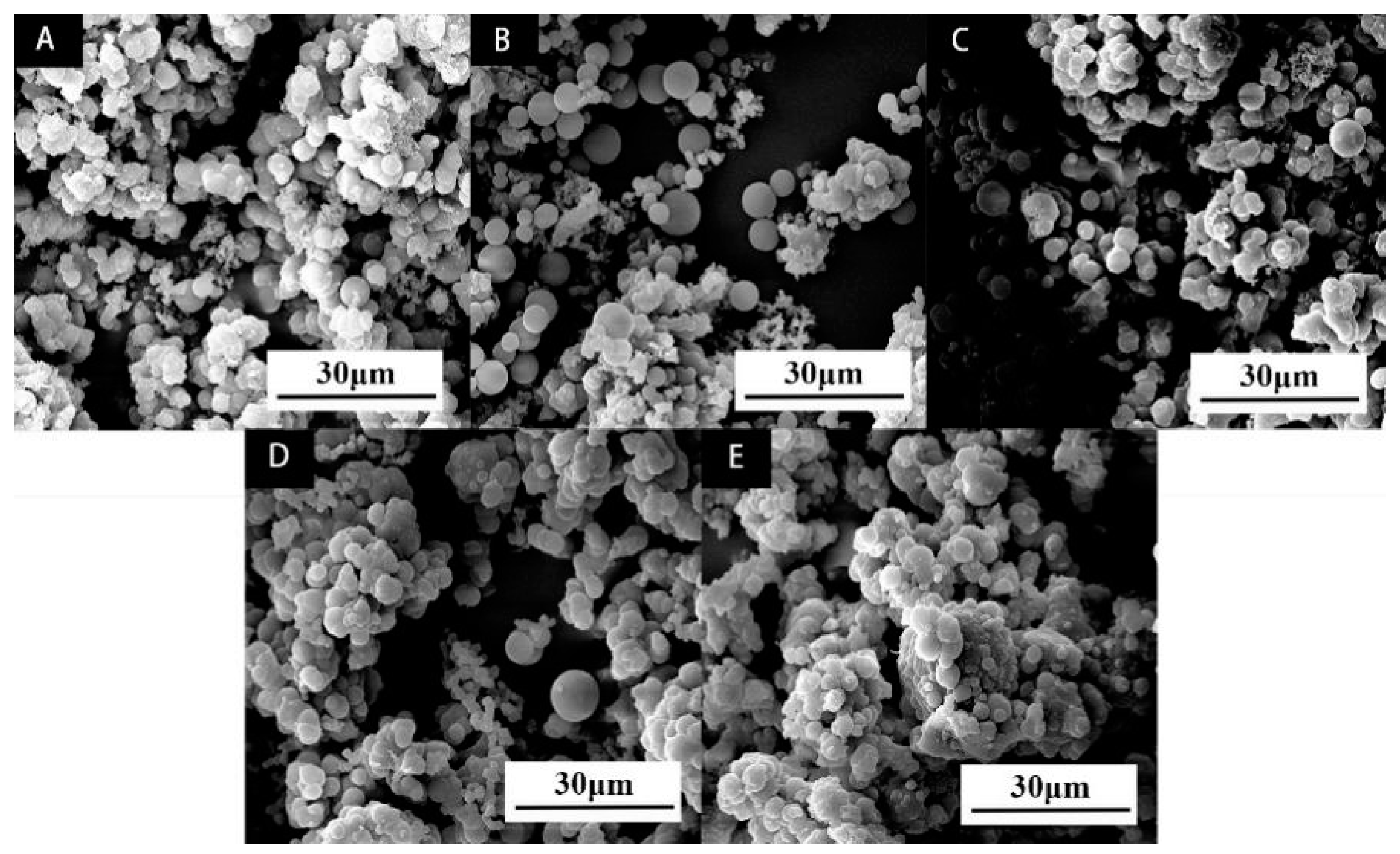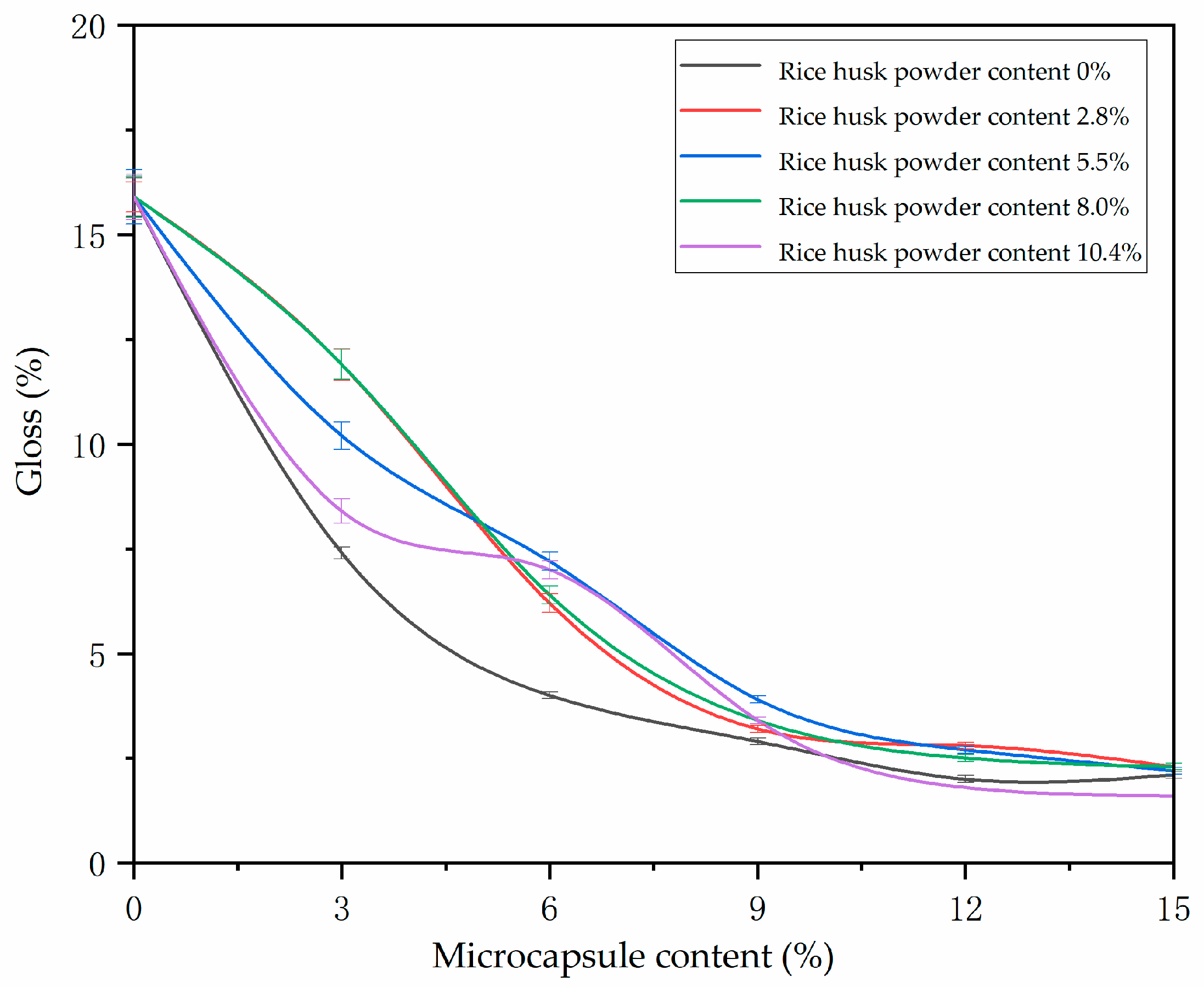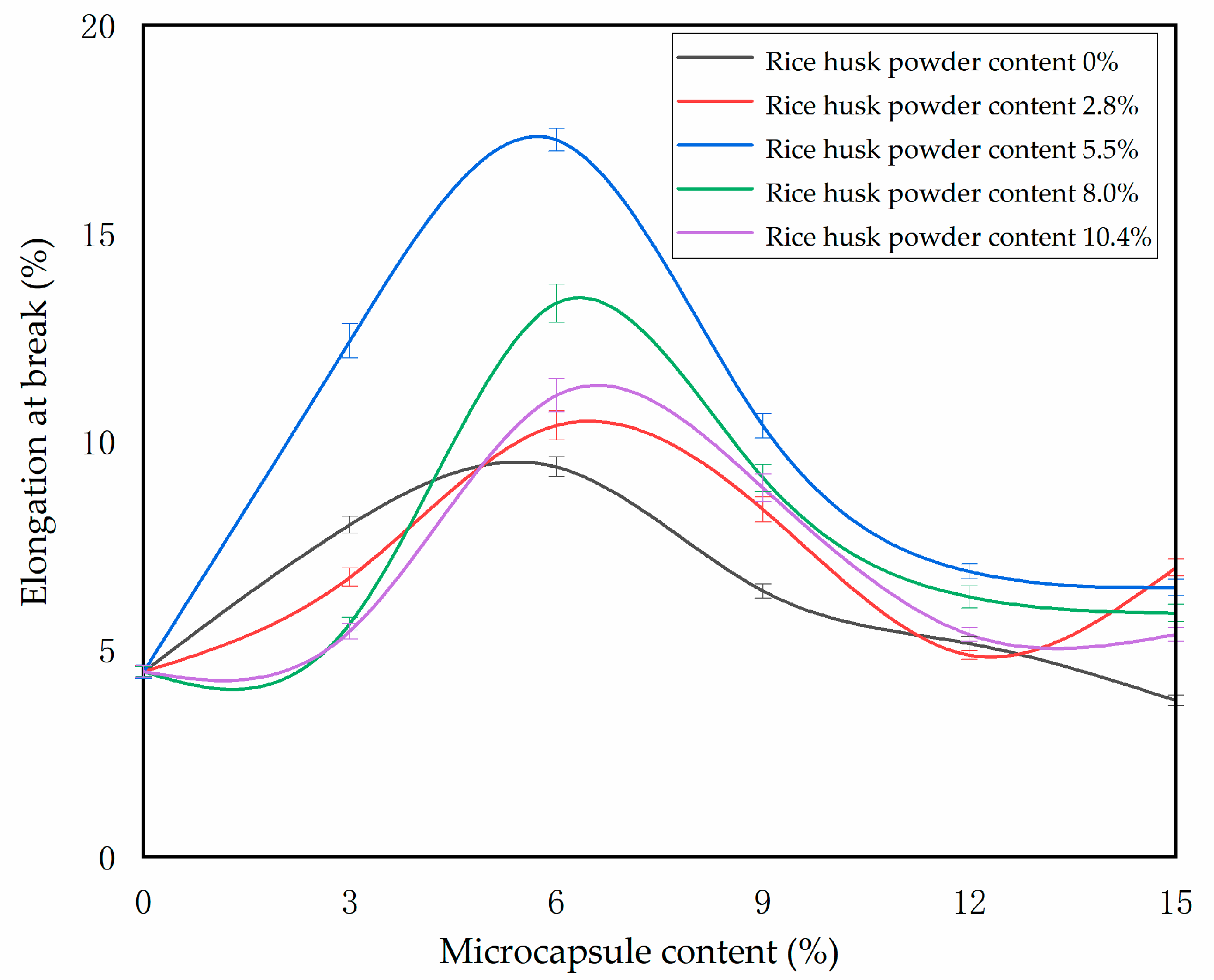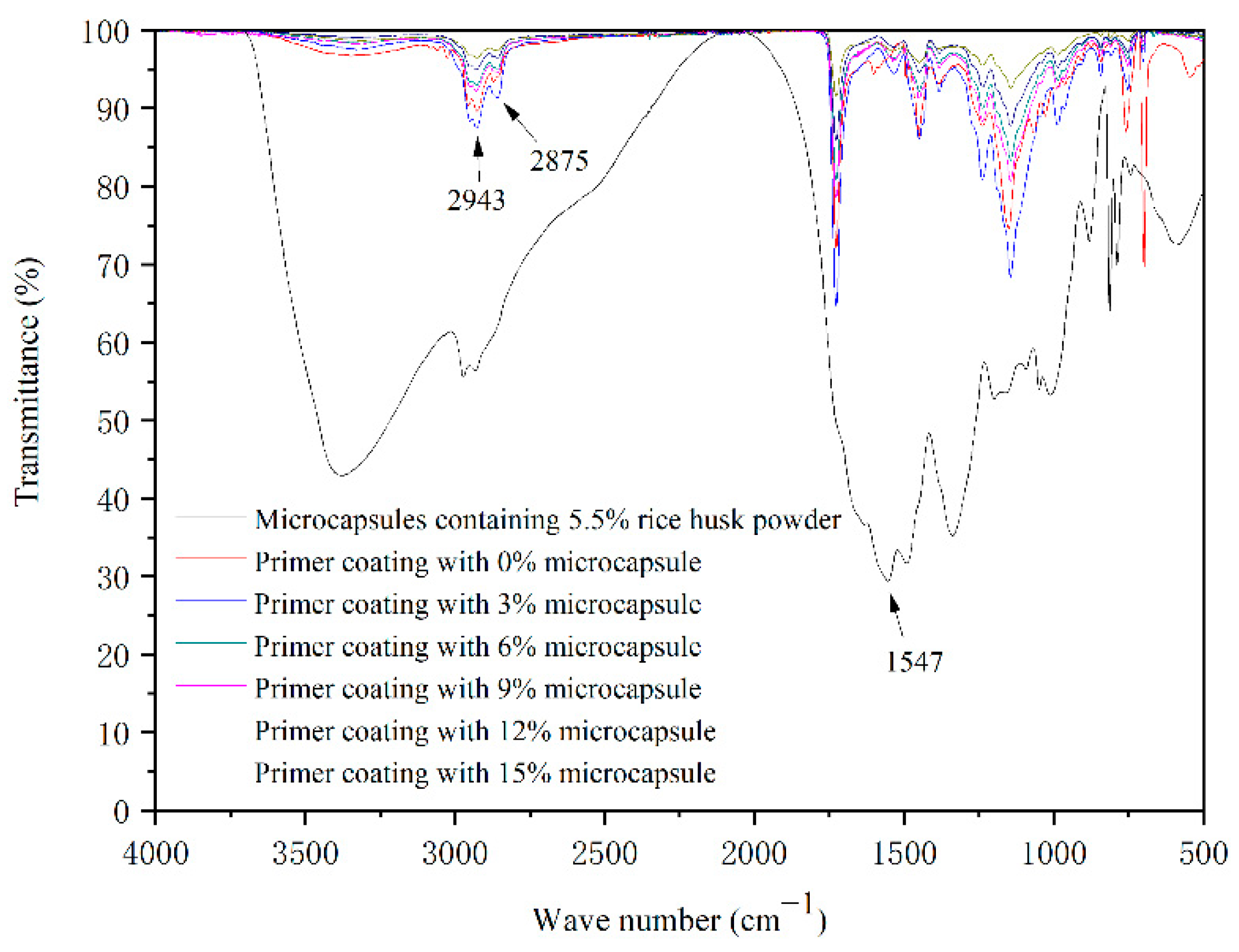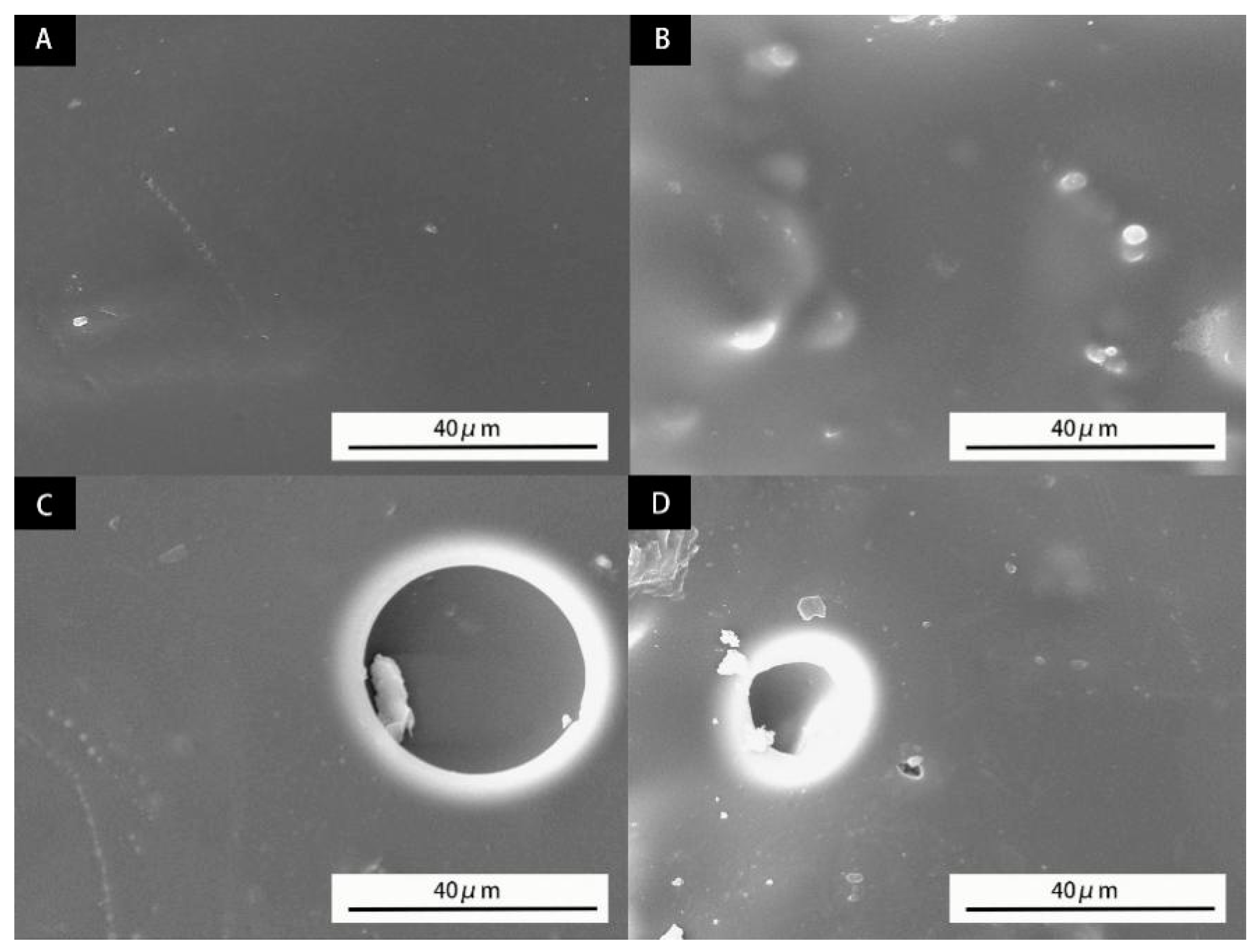3.1. Morphology Characterization of Microcapsules
Figure 1 shows the optical micrograph and infrared spectrum of treated rice husk powder. As shown in
Figure 1A, the length of treated rice husk powder is about 60 μm. The infrared spectrum detection of the treated rice husk powder is shown in
Figure 1B. The wide vibration absorption peak at 3400 cm
−1 is the stretching vibration peak of O-H. At 2921 cm
−1, it is the stretching vibration peak of hydrocarbon bond in -CH
3, 1650 cm
−1 is the bending vibration peak of water molecule signal -OH in cellulose, and 1053 cm
−1 is the vibration absorption peak of C-O-C in cellulose. It can be inferred that the main substance in the treated rice husk powder is cellulose.
The morphology of microcapsules orthogonal samples observed by the Zeiss Axio scope A1 biomicroscope is shown in
Figure 2. With large particle size, the microcapsules of sample No. 1 (
Figure 2A) has irregular particle shape and uneven particle sizes of 30–40 μm or so. Sample 2 (
Figure 2B) forms particles with uniform sizes of 6–8 μm or so and high encapsulating efficiency. Sample 3 (
Figure 2C) is seriously agglomerated, resulting in different particle sizes of products, with particle sizes of about 15–30 μm. Sample 4 (
Figure 2D) is well coated, with less agglomeration and uniform product particles sizes of 5–7 μm. Through the microscopic observation of four samples, it can be seen that both samples No. 2 and No. 4 form microcapsules successfully with high encapsulating efficiency. There are no microcapsules forming in samples No. 1 and No. 3. It is because the low temperature cannot make the prepolymer of melamine and formaldehyde continue to react to form melamine resin as wall material. There is no wall material covering the core material, so the microcapsules cannot be formed [
25].
3.4. Single Factor Experimental Results and Discussion of Microcapsules
The SEM images of microcapsules prepared by single factor optimization experiment of rice husk powder content of wall material are shown in
Figure 4 below. Comparing with five microcapsules with different rice husk powder content, the microcapsules without rice husk powder are shown in
Figure 4A. It can be observed that there are obvious flocs and less complete spherical substances, which may be due to the poor mechanical properties of the wall material and some damage during mixing. Because the short fiber of cellulose in rice husk powder will increase the surface roughness of microcapsules, it can be seen that with the increase of rice husk powder content, some flocs will appear on the surface of microcapsules. The microcapsules with rice husk powder content of 5.5% are round and have an average particle size of about 6 μm. It was observed that the microcapsules containing 2.8%, 5.5%, and 8.0% of rice husk powder content in the wall materials (
Figure 4B–D) are relatively less agglomerated by SEM.
Figure 5 shows the infrared spectra of five microcapsules prepared by a single factor independent experiment. The absorption peak at 1547 cm
−1 belongs to -NH- stretching vibration peak, which belongs to the characteristic peak of melamine resin. The absorption peak at 1157 cm
−1 in the infrared spectrum of microcapsules with rice husk powder in the wall material is split and the peak shape is changed. It can be inferred that this peak is affected by the C-H vibration of the aromatic core and the C-O-C antisymmetric “bridge” stretching vibration peak in rice husk powder. It can be judged that the wall material of the microcapsule contains cellulose [
29]. The absorption peaks at other positions of the infrared spectra of all microcapsules are consistent with those of the microcapsules with a content of 2.8% rice husk powder. It can be concluded that the microcapsules are successfully prepared, and the chemical composition of the microcapsules has not changed.
The microcapsule quality obtained by unit mass core material is taken as the evaluation result, as shown in
Table 7. The low quality of the product may be due to the low conversion of core and wall materials. It can be seen from
Table 7 that the microcapsule yield first increased and then decreased with the increase of rice husk powder content. The reason is that the rice husk powder increases the toughness of the wall material, and the wall material is not easy to crack during the preparation of microcapsules, so the output of microcapsules formed by coating increases. However, if the content of rice husk powder is too high, it will agglomerate during the formation of microcapsules, making the capsule wall materials adhere to each other. The core materials cannot be evenly dispersed during the mixing process, so as to reduce the output of microcapsules [
30].
The coating rate results of microcapsules with different rice husk powder content are shown in
Table 8. With the increase of rice husk powder content in wall material, the microcapsule coating rate increased first and then decreased. When the content of rice husk powder in the wall material increased from 0 to 8.0%, the coating rate increased from 20% to 47%, increasing by 27%. When the content of rice husk powder in the microcapsule wall material reached 10.4%, compared with 8.0%, the coating rate decreased from 47% to 31%, decreased by 16.0%. Because the cellulose of rice husk powder in the microcapsule wall material can enhance the toughness of the wall material, making the microcapsules difficult to crack during the synthesis and stirring process, and the high content of rice husk powder leads to the reduction of melamine resin content in the wall material. The wall material of microcapsule agglomerates seriously, which cannot completely wrap the core material, resulting in the decrease of coating rate [
31].
3.5. Effect of Different Rice Husk Powder Content in Wall Material on Properties of Wood Waterborne Primer
The color difference value of the coating is the main basis for judging whether the coating color is uniform. “
L” represents brightness, “
a” represents the red-green difference, “
b” represents the yellow-blue difference. The date groups of
L1,
a1, and
b1 are obtained at one point on the coating by a color difference meter. Another group of data
L2,
a2, and
b2 are obtained at another point on the coating. The color difference is calculated according to Formula (2).
where:
,
,
.
According to
Figure 6, under the horizontal comparison of microcapsules with the same content of rice husk powder, the color difference value of the coating improves with the increase of the content of microcapsules in the coating. This is because the prepared microcapsules are milky yellow powder. When the addition amount is high, it will change the transparency of the coating and the color of the primer coating to affect the color difference value. The influence of microcapsules with different rice husk powder content on the color difference is not obvious. The color difference value of microcapsules with 2.8% rice husk powder in wall material increased from 0.51 to 3.37, and the color difference value of microcapsules with 5.5% rice husk powder in wall material increased from 0.51 to 2.53. The reason is that the particle size of microcapsules is small and uniform. It is easy to be evenly distributed in the coating, so the influence on the color difference is low. With the content of microcapsules between 0~9%, the content of microcapsules has little effect on the color difference of waterborne primer coating. In this range, the color difference of microcapsules with rice husk powder content of 5.5% increased from 0.51 to 0.64, which had the least effect on the color difference of primer coating.
Gloss is to test the specular reflection ability of the coating surface to light, and it is the judgment basis of the smoothness of the coating surface. The test results are shown in
Figure 7. It can be observed from
Figure 7 that the gloss of the coating decreases with the increase of microcapsule content. This is because the microcapsules are spherical solid powders. The increase of microcapsule content in the coating will increase the roughness of the coating surface, resulting in diffuse reflection of light and low gloss of the coating surface. When the microcapsule content is 0~6%, it has the least effect on coating gloss.
The mechanical properties of waterborne coatings on wood surfaces are generally low. The prepared microcapsules with different content of rice husk powder in wall materials were added into the water-based primer for the hardness test, and the results are shown in
Table 9. The hardness of the coating increases with the increase of microcapsule content. Under the condition of different rice husk powder content, when the rice husk powder content in wall material is more than 5.5%, the coating hardness reached 6H, indicating that the coating hardness increases with the increase of rice husk powder content in wall material.
The adhesion of water-based primer coatings with different microcapsules and different contents was tested by a film scribing instrument. The results are shown in
Table 10. When the amount of microcapsule with rice husk powder in wall materials is 3–9%, the adhesion level of the coating is level 1 and level 2. That is, when the amount of microcapsules is 3–9%, the adhesion of the coating is better. When the content of rice husk powder remains unchanged, the adhesion of primer coating gradually decreases with the increase of microcapsule addition, which is due to the increase of microcapsule addition, resulting in more particles in the coating, which make the decrease of interfacial adhesion between coating and wood and between coating and coating, so as to reduce the adhesion of coating [
32].
The impact resistance of the prepared waterborne primer coating is tested by the coating impactor tester, and the test results are shown in
Table 11. The impact resistance of the coating first increases and then decreases with the increase of microcapsule content. When the content of microcapsules is 6–12%, the impact strength of the coating containing 5.5% and 8.0% rice husk powder in the microcapsule wall material is above 10 kg·cm. It may be because the microcapsule increases the mechanical properties of the coating. However, with the increase of microcapsule concentration, the microcapsule will agglomerate in the coating, which reduces the adhesion of the coating and is difficult to withstand the impact of external forces. Thus, the impact resistance of the coating is reduced [
33].
The elongation at the break of the waterborne primer is measured by the universal mechanical testing machine. The calculation results are shown in
Figure 8. It can be seen that the elongation at the break of the primer coating increases first and then decreases with the increase of the content of microcapsules in the coating. The wall material of the microcapsule contains rice husk powder, which is plant cellulose. Adding it to the waterborne primer will significantly improve the toughness of the coating itself. Once the content of rice husk powder increases, the particle size of microcapsules is uneven and easy to agglomerate, which will make the coating uneven and brittle to reduce the toughness and easy to fracture [
34]. When the amount of rice husk powder was 5.5% and the amount of microcapsule was 6.0%, the elongation at break of the primer coating is the highest 17.24%, which increases by 12.79%. and the tensile property is the best.
Based on the above test results, the primer coating with the microcapsules containing 5.5% rice husk powder in the wall material has excellent optical and mechanical properties. The microstructure of primer coatings with different contents of microcapsules (rice husk powder content 5.5%) was observed by environmental scanning electron microscope, as shown in
Figure 9. It can be observed that the surface of the primer coating without microcapsules is smooth. With the increase of microcapsule content, the surface of the coating became rough. When the microcapsule content is less than 6%, the microcapsule particles are evenly dispersed in the coating without obvious protrusions. For the coating with microcapsule content greater than 6%, the microcapsules can be observed to form agglomeration and many protrusions on the coating surface.
The microcapsules with rice husk powder content of 5.5% and the waterborne primer coatings with different contents of microcapsules (rice husk powder content of 5.5%) were detected by Fourier transform infrared spectrometer. The results are shown in
Figure 10. At 2943 cm
−1 and 2875 cm
−1, they are the characteristic absorption peaks of methyl and methylene, which are mainly the characteristic chemical bonds of waterborne acrylic acid (the main component of the primer) [
35]. The absorption peak at 1547 cm
−1 belongs to -NH- stretching vibration peak, which belongs to the characteristic peak of melamine resin [
36]. There is an absorption peak in the aqueous coating with microcapsules, which proves that microcapsules exist in the coating. Other characteristic absorption peaks of the coating do not disappear, indicating that the microcapsules do not produce a chemical reaction with the coating, and the coating composition is still stable after adding microcapsules.
The waterborne primer with 6.0% microcapsules addition has good toughness, optical properties, and mechanical properties. Therefore, this sample is selected for the aging resistance test and compared with the blank sample. After UV aging, the color difference of the primer without microcapsules changes more, and the gloss decreases more obviously than that of the primer with 6% microcapsules, indicating that adding microcapsules to the waterborne primer coating can improve the aging resistance of the coating (
Table 12). In
Figure 11, it can be observed that almost no particles can be seen in the primer coating without microcapsules before aging. After aging, it can be clearly observed that the primer coating without microcapsules has large bubbles with a diameter of 40 μm. The bubble diameter of primer coating with 6% microcapsule is only 15 μm, which further proves that microcapsules increase the stability and aging resistance of waterborne primer coating. This is because the surface of the coating will be damaged by bubbles during aging. According to the previous measurement of the elongation at the break of the coating, the coating with microcapsules has strong toughness, so it is not easy to crack after bubbles are generated. After cracking, the outflow of cystic substances at the crack will reduce the crack to stabilize the surface optical resistance of the coating and reduce the bubble size.
The scratch control experiment was carried out between the waterborne primer coating with 6.0% microcapsule and without microcapsule. The scratches on the first and fifth days were recorded respectively. The results are shown in
Figure 12.
Figure 12A,C show the coating scratches without microcapsules. It can be seen that the scratches increased by 2.78 μm after 5 d. This is because the crack will gradually expand under the influence of environmental factors.
Figure 12B,D show the primer coating added with 6.0% microcapsules. The scratch was reduced from 30.23 μm to 24.51 μm after 5 d with scratch size reduction of 5.72 μm. The repair rate was about 18.9%. When the external load leads to the cracking of the waterborne primer, the microcapsule wall at the crack is torn, and the repair components of the capsule core flow from the microcapsule to the crack under the siphon action. The repair agent core material shellac is naturally physically cured at room temperature, which can block and bridge the microcracks to reduce the cracks of the waterborne coating to a certain extent.



